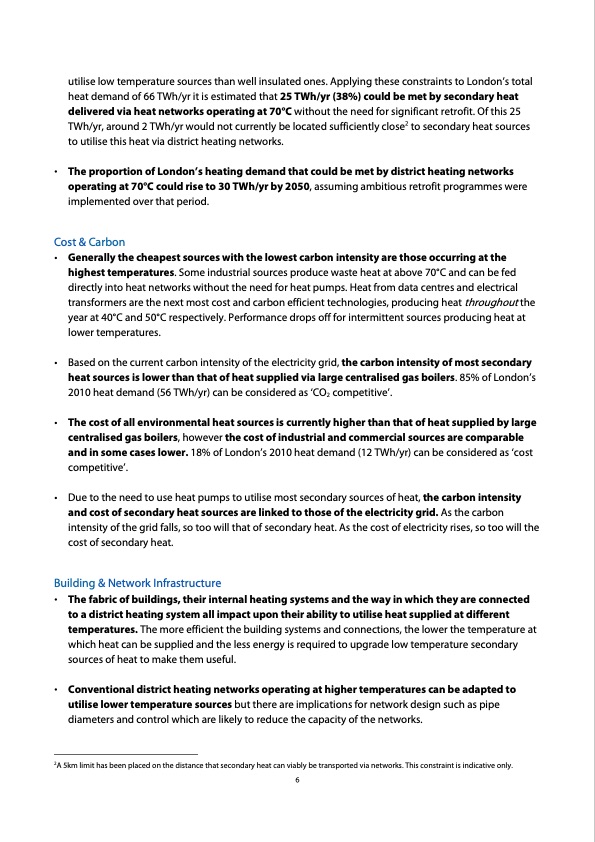
PDF Publication Title:
Text from PDF Page: 006
utilise low temperature sources than well insulated ones. Applying these constraints to London’s total heat demand of 66 TWh/yr it is estimated that 25 TWh/yr (38%) could be met by secondary heat delivered via heat networks operating at 70°C without the need for significant retrofit. Of this 25 TWh/yr, around 2 TWh/yr would not currently be located sufficiently close2 to secondary heat sources to utilise this heat via district heating networks. • The proportion of London’s heating demand that could be met by district heating networks operating at 70°C could rise to 30 TWh/yr by 2050, assuming ambitious retrofit programmes were implemented over that period. Cost & Carbon • Generally the cheapest sources with the lowest carbon intensity are those occurring at the highest temperatures. Some industrial sources produce waste heat at above 70°C and can be fed directly into heat networks without the need for heat pumps. Heat from data centres and electrical transformers are the next most cost and carbon efficient technologies, producing heat throughout the year at 40°C and 50°C respectively. Performance drops off for intermittent sources producing heat at lower temperatures. • Based on the current carbon intensity of the electricity grid, the carbon intensity of most secondary heat sources is lower than that of heat supplied via large centralised gas boilers. 85% of London’s 2010 heat demand (56 TWh/yr) can be considered as ‘CO2 competitive’. • The cost of all environmental heat sources is currently higher than that of heat supplied by large centralised gas boilers, however the cost of industrial and commercial sources are comparable and in some cases lower. 18% of London’s 2010 heat demand (12 TWh/yr) can be considered as ‘cost competitive’. • Due to the need to use heat pumps to utilise most secondary sources of heat, the carbon intensity and cost of secondary heat sources are linked to those of the electricity grid. As the carbon intensity of the grid falls, so too will that of secondary heat. As the cost of electricity rises, so too will the cost of secondary heat. Building & Network Infrastructure • The fabric of buildings, their internal heating systems and the way in which they are connected to a district heating system all impact upon their ability to utilise heat supplied at different temperatures. The more efficient the building systems and connections, the lower the temperature at which heat can be supplied and the less energy is required to upgrade low temperature secondary sources of heat to make them useful. • Conventional district heating networks operating at higher temperatures can be adapted to utilise lower temperature sources but there are implications for network design such as pipe diameters and control which are likely to reduce the capacity of the networks. 2A 5km limit has been placed on the distance that secondary heat can viably be transported via networks. This constraint is indicative only. 6PDF Image | LONDONS ZERO CARBON ENERGY RESOURCE Secondary Heat

PDF Search Title:
LONDONS ZERO CARBON ENERGY RESOURCE Secondary HeatOriginal File Name Searched:
031250_GLA_Secondary_Heat___Summary_Report.pdfDIY PDF Search: Google It | Yahoo | Bing
NFT (Non Fungible Token): Buy our tech, design, development or system NFT and become part of our tech NFT network... More Info
IT XR Project Redstone NFT Available for Sale: NFT for high tech turbine design with one part 3D printed counter-rotating energy turbine. Be part of the future with this NFT. Can be bought and sold but only one design NFT exists. Royalties go to the developer (Infinity) to keep enhancing design and applications... More Info
Infinity Turbine IT XR Project Redstone Design: NFT for sale... NFT for high tech turbine design with one part 3D printed counter-rotating energy turbine. Includes all rights to this turbine design, including license for Fluid Handling Block I and II for the turbine assembly and housing. The NFT includes the blueprints (cad/cam), revenue streams, and all future development of the IT XR Project Redstone... More Info
Infinity Turbine ROT Radial Outflow Turbine 24 Design and Worldwide Rights: NFT for sale... NFT for the ROT 24 energy turbine. Be part of the future with this NFT. This design can be bought and sold but only one design NFT exists. You may manufacture the unit, or get the revenues from its sale from Infinity Turbine. Royalties go to the developer (Infinity) to keep enhancing design and applications... More Info
Infinity Supercritical CO2 10 Liter Extractor Design and Worldwide Rights: The Infinity Supercritical 10L CO2 extractor is for botanical oil extraction, which is rich in terpenes and can produce shelf ready full spectrum oil. With over 5 years of development, this industry leader mature extractor machine has been sold since 2015 and is part of many profitable businesses. The process can also be used for electrowinning, e-waste recycling, and lithium battery recycling, gold mining electronic wastes, precious metals. CO2 can also be used in a reverse fuel cell with nafion to make a gas-to-liquids fuel, such as methanol, ethanol and butanol or ethylene. Supercritical CO2 has also been used for treating nafion to make it more effective catalyst. This NFT is for the purchase of worldwide rights which includes the design. More Info
NFT (Non Fungible Token): Buy our tech, design, development or system NFT and become part of our tech NFT network... More Info
Infinity Turbine Products: Special for this month, any plans are $10,000 for complete Cad/Cam blueprints. License is for one build. Try before you buy a production license. May pay by Bitcoin or other Crypto. Products Page... More Info
| CONTACT TEL: 608-238-6001 Email: greg@infinityturbine.com | RSS | AMP |